This is a post trying to start a series about mythical creatures and the science for their explanation. My first attempt was about Vampires a long time ago! Now that it is almost Halloween it would be a perfect moment to continue. So, without further delay, let's get into it.
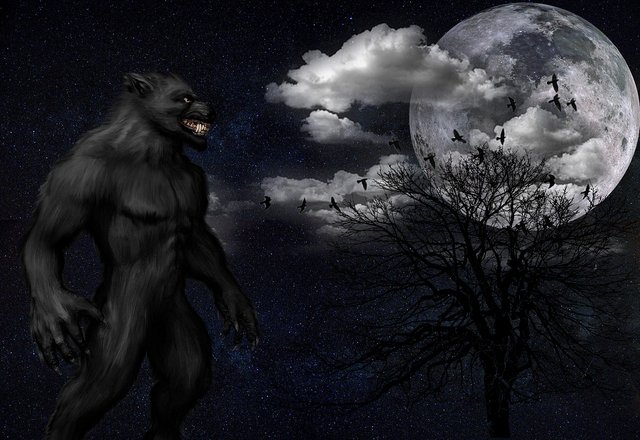
(1)
Werewolves, those humans that turn into a wolf-like beast full of hair and animal instincts at the rise of the full moon...
Now explained with Science!
History

(2)
In the past, a lot of people underwent a mythical transformation into a wolf, concept known as Lycanthropy. In the beginning it was as an initiation for warriors, but then it was believed in folklore to be a real transformation. Hence, carried on to the concept we have of a werewolf now. But... how did it happen?
Proto-Indo-Europeans Civilization

(3) Map of the Proto-Indo-European Migrations
It is around the year 2000 BCE, during the period of the migrations of the Indo-European, in which psuedosocieties were consisting of warriors and hunters. Werewolves problably started here, as it is suggested that warriors underwent lycanthropy as an initiation in their new position.
Now, to do that, it was suggested that they had to kill and wear the skin of a wolf, plus other steps that we are not sure of.
There were found dog sacrifices of around 2000 BC in Russia, which would point that yes, lycanthropy was tried at least as means of initiation.
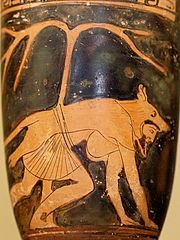
(4) Dolon crawling
with wolf skin
Ancient Greece
There was a famous tale in which Lycaon the king of the old Arcadia, tested Zeus by serving him flesh of a child. In response, he turned him into a wolf.
As well, there were some stories from Herodotus the traveller, which wrote around 440 BC that the Neuri tribe would transform into wolves and then back into humans once a year. He thought that these people may be conjurers.
As a final note here, there were people like Dolon in their mythology who followed a ritual similar to lycanthropy to become a warrior as well!
Middle Ages
Surprisingly enough, in early medieval codes, the meaning of a werewolf was the one of an outcast. However, the typical folkloric stories still existed (and were preferred by people of course!).
Usually, the stories represent a negletected man from high power (like a king or knight) that is trapped in a beast form in a periodic manner.

(5)
Early Modern Era
The stories continued to spread, however, around the 16th century, some stories started to include certain conditions for the lycanthropy to happen like the brewing of a beer. However, the most important one (and the one that we know now) is the prevalence of the Full Moon as one of those key ingredients.
Science time!

(6)
So, alright. We should go to each characteristic of our creature one by one, and check if it was in people's heads or that they actually saw someone (or something) similar to a werewolf!
Hair
This is the first characteristic that you would see in our animal/beast. Luckily for us, we have one medical condition which would make for an increased amount of hair!
The condition (phenomenom) is called Hypertichosis (or Werewolf syndrome).
Patients with this condition grow a lot of hair in their bodies. How much? Well, depends on the type of the condition as it ranges from normal physiological characteristic to wild werwolf-like person. So, let's start!

(7) Lanugos at the shoulders
Congenital hypertrichosis lanuginosa (& terminalis)* is one type which is actually physiological, meaning it is normal. Its variant terminalis however, is not as it continues throughout the life of the patient.
Congenital means that is inborn.
lanuginosa that forms lanugos.
It happens in newborn babies, and I think everyone is familiar with these.
I think we can agree it has a low probability to get confused with a werewolf.
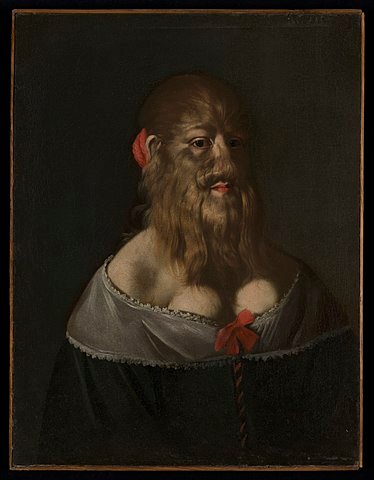
(8) Don't tell me she doesn't look a bit like a wolf!
On the other hand, Congenital hypertrichosis terminalis is another story.
It tends to be generalized as those lanugos grow and then body hair grows everywhere!
There are plenty of pictures on the internet of sufferers of this condition. But to stick with a historical theme, I bring you the real portrait on the right of Barbara van Beck!
For our people, it could be confused as they would think the person is becoming a werewolf over time! (And they may blame the parents as well? Who knows).
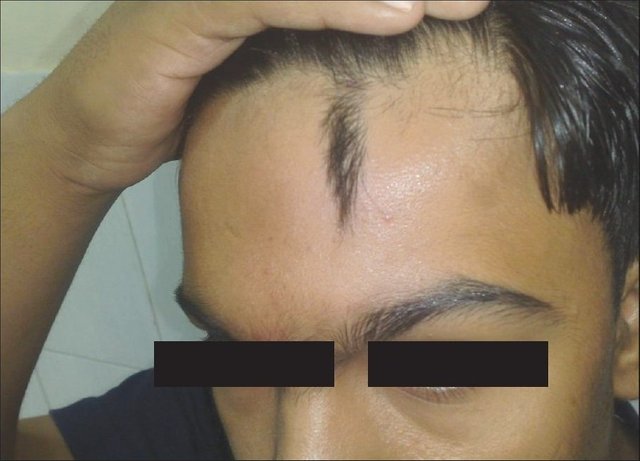
(9) Patch of hair in a patient with nevoid hypertrichosis
Nevoid hypertrichosis is the second type, in which excessive hair growth appears in "patches", generally with different number of them.
For our people, it can be confused with a person undergoing lycanthropy!
Hirsutism is the third type we are going to discuss. This one is exclusive to females, as it is related to the hormones. The problem here is that more masculine hormones are produced, and then body starts to grow in the places where in men grow, such as in the chin (beard).
It is a rather small effect, so I would say it is not really likely to say a woman is a werewolf because of 3 extra hairs in the chin region.
Believing to see or be a wolf
There have been reports on the 19th century of people starting to believe themselves to be a wolf. Clinical lycanthropy was called. However, I couldn't find confirmed information about it.
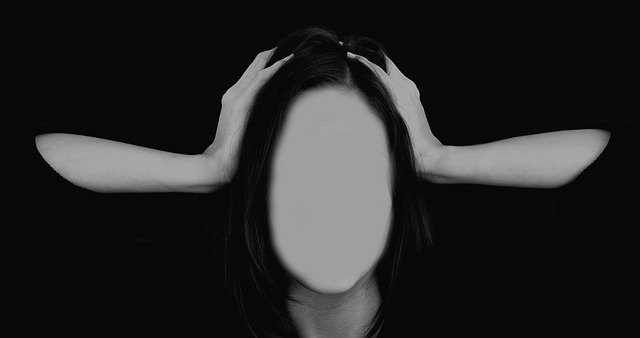
(10)
But which medical condition could fit in this description?
Delusional Misidentification Syndrome
This is a group of conditions characterized by delusions of self-identification made by the patient. Almost always with an underlying mental condition.
It has different groups of illnesses in it. It ranges from thinking that you have another double replacing you (Syndrome of subjective doubles) to the Capgras syndrome, where the subject things that someone he knows has been replaced with an identical person.
You would say: "nah, this is an overstretch right?"
I thought the same until I stumbled with this article (mentioned down below).

(11)
It is a case report about a man that was showing signs of psychosis with animal type of behaviours. He was howling in his psychiatric room! Finally he believed he was a werewolf. The conclusion that his doctor diagnosed was a really obscure type of Delusional Misidentification Syndrome.
Our historical people should have not only seen individuals that look like a werewolf, they should have also seen & heard somebody that believes himself a wolf right?
This would fit right into it!
Either that or diagnose some individuals with Schizophrenia and assume they saw creatures.
Full Moon?
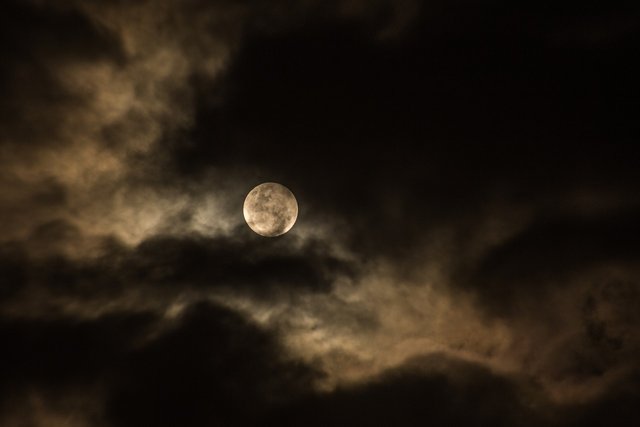
(12)
This is just a tough characteristic to have clear concepts about in the real world. When speaking about werewolves, there is a famous report which indicates that Full Moon and disturbed behaviour are closely linked.
Then, there is this study & this one and which also links extra psychiatric patients on days of Full Moon but also New Moon.
One of these links it to how gravity of the moon will change intra- or extracellular fluids, neural & endocrine (glands and hormones) functions.
However, I find these are arguments too vague. It is a topic that is poorly researched and maybe it has more of a psicological effect than anything else. Or maybe it is another example of the famous saying: "Correlation is not Causation". Only time and more reasearch would throw a light on it. If true, we have our last ingredient for "proving" our werewolves for the ancient people.
Conclusion

(13)
According to my research, it is definitely plausible that people in ancient times could confuse very real medical conditions and effects for the apparition of werewolves.
From appearance to behaviour (kind of!).
In the end, one can only but wonder what were in the heads of our historical people when they saw now known clinical cases.
Closing
I hope this post has been interesting for you!
I hope I can be more active in Steemit and the STEM community, even though I took a looooong break all Summer
Special thanks to the kind people at r/werewolves on Reddit for helping in the search of some data.
Have a spooky Halloween!
This is @deholt, signing off!
Information Sources
- Werewolf Legends - at History.com by its writers
- The dogs of war: A Bronze Age initiation ritual in the Russian steppes - by David W., AnthonyDorcas & R.Brown at ScienceDirect
- A Brief History of Werewolves - by Deane Lewis at dl.id.au
- The Medieval Werewolf - by Dr Amanda Hopkins at the University of Warwick
- Hypertrichosis (Werewolf Syndrome) - reviewed by Alana Biggers, MD at healthline.com
- Real-Life Werewolves: Psychiatry Re-Examines Rare Delusion - by Bahar Gholipour, Staff Writer of LiveScience
- Clinical Lycanthropy: Delusional Misidentification of the “Self” - by Rajeet Shrestha , M.D. at neuropsychiatryonline.org
- Delusional Misidentification Syndromes - at PubMed by Kamil Atta, MD, Nicholas Forlenza, MA; Mariusz Gujski, MD, PhD; Seema Hashmi, MD; and George Isaac, MD
- What is Capgras Syndrome - by Timothy J. Legg, PhD, CRNP at healthline.com
- Syndrome of subjective doubles - by Christodoulou GN at the American Journal of Psychiatry
- The dark side of the moon - by Leonie A Calver, Barrie J Stokes, and Geoffrey K Isbister at the Medical Journal of Australia
- Human aggression and the lunar synodic cycle - by Lieber AL. at PubMed
- Lunar phase cycle and psychiatric hospital emergency visits, inpatient admissions and aggressive behavior. - by Kazemi-Bajestani SM Amirsadri A, Samari SA, and Javanbakht A. at Elsevier
Image Sources
- (1) - CC0 - at Pixabay by LeoderLiebe
- (2) - CC0 - at Pixabay by PublicDomainPictures
- (3) - CC BY-SA 4.0 - at WikiMedia Commons by Joshua Jonathan
- (4) - Public Domain - picture by Jastrow
- (5) - CC0 - at Pixabay by annca
- (6) - CC0 - at Pixabay by DarkoStojanovic
- (7) - CC0 - at WikiMedia Commons
- (8) - CC BY-SA 4.0 - at WikiMedia Commons by Wellcome Images for taking the picture of the painting
- (9) - CC BY-SA 3.0 - at PubMed (figure 1) by their authors Lipy Gupta, Ram Kishan Gautam, and Minakshi Bharadwaj
- (10) - CC0 - at Pixabay by geralt
- (11) - CC0 - at Pixabay by mohamed_hassan
- (12) - CC0 - at Pixabay by Pexels
- (13) - CC0 - at Pixabay by OpenClipart-Vectors
Today we forgot how is it like when we are feeling our deepest fears.
Most of the people have never experienced the real wilderness during the night.
Even with a gun, it's not pleasant when all the sounds amplify during the night and every shadow could be the last thing you will see.
Just imagine how many attacks actually happened.
Downvoting a post can decrease pending rewards and make it less visible. Common reasons:
Submit
We right now live in an era of comfort that was never achieved before in human history. We have warm shelters, "infinte" supplies and water, and are provided with electrical energy which makes our lives easier.
What makes any kind of story about supernatural creatures believable is the fear of true wilderness, of the unknown. And I think this unknown fear is what tends to distort perceptions of reality given the right conditions.
Thanks for your comment!
Downvoting a post can decrease pending rewards and make it less visible. Common reasons:
Submit
Nice to see some halloween-themed scientific musings.
Downvoting a post can decrease pending rewards and make it less visible. Common reasons:
Submit
That is why I thought it was worth it a go for these days!
Downvoting a post can decrease pending rewards and make it less visible. Common reasons:
Submit
This is an extremely interesting subject to explore! :)
You have assembled a great piece here! Very interesting, indeed! I can only imagine what a few more hairs could do back in the Middle Ages ?! One would definitely be accused of being a witch, a werewolf or a devil...
We are so lucky that these times have already passed!
Downvoting a post can decrease pending rewards and make it less visible. Common reasons:
Submit
That is why I is interesting to analyse as it can give us a bit of insight in why they tought these creatures exist and how ignorance can lead to confussion. And who knows, maybe we think weird things about processes that actually may have an explanation not known for us yet!
Thanks gor your comment!! :D
Downvoting a post can decrease pending rewards and make it less visible. Common reasons:
Submit
Sadly, it still happens.
Downvoting a post can decrease pending rewards and make it less visible. Common reasons:
Submit
Looks graceful and sublime!
Downvoting a post can decrease pending rewards and make it less visible. Common reasons:
Submit
I upvoted your post.
Keep steeming for a better tomorrow.
@Acknowledgement - God Bless
Posted using https://Steeming.com condenser site.
Downvoting a post can decrease pending rewards and make it less visible. Common reasons:
Submit
This post has been voted on by the SteemSTEM curation team and voting trail in collaboration with @utopian-io and @curie.
If you appreciate the work we are doing then consider voting all three projects for witness by selecting stem.witness, utopian-io and curie!
For additional information please join us on the SteemSTEM discord and to get to know the rest of the community!
Downvoting a post can decrease pending rewards and make it less visible. Common reasons:
Submit
Congratulations @deholt! You have completed the following achievement on the Steem blockchain and have been rewarded with new badge(s) :
Click here to view your Board of Honor
If you no longer want to receive notifications, reply to this comment with the word
STOPDo not miss the last post from @steemitboard:
Downvoting a post can decrease pending rewards and make it less visible. Common reasons:
Submit
Congratulations @deholt! You have completed the following achievement on the Steem blockchain and have been rewarded with new badge(s) :
Click here to view your Board of Honor
If you no longer want to receive notifications, reply to this comment with the word
STOPDo not miss the last post from @steemitboard:
Downvoting a post can decrease pending rewards and make it less visible. Common reasons:
Submit